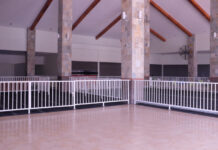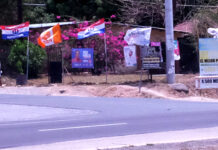Juan Carlos Varela’s pet project — will it come to fruition in its anticipated form? That this photo has disappeared from the Presidencia’s website is an ordinary if unfortunate attribute of a change of presidents. But some of Nito Cortizo’s comments about the nature and amount of Panama’s debt, the backlog of unfinished public works projects and his austerity plans cast some doubts about this. It would be hard to imagine him accepting this as it is without his own independent studies.
Can Cortizo jump-start construction? How?
by Eric Jackson
We have just seen a polite and ordinary transfer of the presidency, if one is to judge it just by ceremonial protocols. But look behind the pomp and you will find a country in difficult circumstances, and may notice that the incoming president has complained that the books he received are incomplete.
By Laurentino “Nito” Cortizo’s reckoning, and by what generally appears in the published record, the Republic of Panama’s public debt has roughly tripled over the past 10 years. If the records are incomplete or fictitious, by many accounts some of that would be for the purpose of some newly wealthy — or wealthier — individuals avoiding prison time for bribery or peculation.
Cortizo has expressed an interest in dealing with so much past political practice that leaves abandoned projects with each change of government. You can see its monuments all over. Some are public, some are private — in the latter cases, quite often there was an expectation of some sort of public investment, subsidy or tax break. There are all of these empty finished or unfinished buildings, in some of which the government holds a stake. Going west on the Pan-American Highway descending Cerro Campana, notice the grandstands of an abandoned auto racetrack off to the left. Driving down the country’s main drag you will notice several unfinished public schools. There are Metro stations shown on the little maps on the train cars, which are still in the realm of theory. The new president will need to take the state of the private sector into account, but for right now he has ordered an inventory of all the unfinished public works projects, and not just those of the Varela years.
In the run-up to his inauguration, Cortizo said that among his first priorities will be reforms to the public contracting law to put more transparency into the processes, and that his budgets will be austere. But as a sometimes construction man himself — his generally cited main private sector occupation being cattle breeder — Nito has vowed to get the construction sector working again.
Now we see the first of the specific proposals. There is a special reduced interest rate for those buying their first homes which are priced between $35,000 and $120,000. Some private banks won’t go along with the program but the public ones do. Cortizo proposes to raise the upper limit to $180,000.
The preferential interest rate program goes back to Noriega time and has not made a dramatic impact outside of the Panama City and San Miguelito metro area. As to city properties, industry analysts argue about how much of a boost it has really given. But all credible and informed observers — excluding those who spout BUY NOW!!! hype — agree that Panama is way overbuilt and that it will take many years to absorb all the excess inventory in the real estate market. The expulsion of the “permanent tourists,” the restrictions against Venezuelan immigration, the secondary effects of the Panama Papers scandals that make paper real estate dealings here a riskier money laundering proposition and make the financial transactions of rich people who move here slower and more bureaucratic — all of these things are factors in the real estate slowdown but it’s hard to separately quantify any of them.
Cortizo’s construction and real estate policies may run into complications within his own party. Are we to encourage more foreigners to move here? That would annoy xenophobes in the PRD. Will the deadly old feud between the PRD and the SUNTRACS construction workers’ union — the continuation of an ideological war with its leftist leaders that was worst in the early days of the dictatorship and has never gone away — come into play again?
Then there are questions about whether the new president has an overall national development vision, if so what it is, and whether it would be compatible the parochial interests of various people in his party. For example, would he go ahead with a bullet train along a route that would be quite convenient for the Varela family’s distilling business but doesn’t directly serve the Ngabe-Bugle Comarca, and which mostly favors already developed areas along the Pan-American Highway instead of promoting new development polls inland and uphill? With the PRD winning most of the local offices, there would be mayors and representantes of that party whose communities would win or lose on any determination of a new railway between the capital and Chiriqui province.

Ah, the Edificio Aqua Tower. The skeleton of this, financed by a loan from the state-owned Caja de Ahorros bank, still stands. Built on the sand of Playa Blanca with insufficiently reinforced foundations, if they finished this 13-story “upscale” residential development as is it would collapse under its own weight.
These links are interactive — click on the boxes













